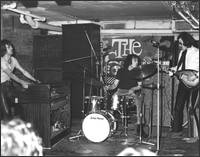| One of the first art-rock bands to experiment with classical forms and fusion, the Nice was an early vehicle for the talents of keyboard virtuoso Keith Emerson, who plundered Mozart, Sibelius, and Tchaikovsky for his extended rock instrumental forays. The group began as the backing band for British soul singer P.P. Arnold and also featured guitarist David O'List, drummer Brian "Blinky" Davison, and bassist Lee Jackson. In October 1967, only two months after formation, the group split from Arnold, christened itself the Nice, and released a single called "The Thoughts of Emerlist Davjack," which became the title track of their 1968 debut album. The Nice quickly built a reputation as an exciting, theatrical live band thanks to Emerson, who dressed in gold lame, hurled knives into his Hammond organ to produce strange sounds, and mimed masturbation onstage. Emerson's antics spawned controversy with Ars Longa Vita Brevis, which contained a cover of Leonard Bernstein's West Side Story song "America." The Nice performed it at the Royal Albert Hall while burning an American flag, and Bernstein subsequently attempted to stop the song's release in the U.S. Emerson had emerged as the star of the group, both in terms of instrumental skill and showmanship, and the fed-up O'List had departed the group by the time of the album's release to join Roxy Music. Nice and Five Bridges Suite became big hit albums in Britain, but the group never broke through in America. In 1969, Emerson met Greg Lake, then with King Crimson, on a U.S. tour, and broke up the Nice in frustration in 1970 due to its lack of success. He, Lake, and drummer Carl Palmer formed the much more popular Emerson, Lake and Palmer, which expanded on Emerson's innovations with the Nice. The remaining Nice members went on to several short and/or unsuccessful stints with other groups before fading away.
Steve Huey, All Music Guide
|


